Previous Chapter « Table of Contents » Next Chapter
Production paving of the control mix began on August 22, 2007 and continued for four days. The plant was located in Cody, Wyoming approximately 53 miles (85 km) from the project. The distance provided for a 90 minute one-way haul primarily uphill.
In general, mixture laydown temperatures ranged from 300 to 325 °F (149 to 160 °C). Paving weather was favorable for this time of year in Yellowstone National Park therefore only minimal heat loss occurred during the transportation of the mix. Morning temperatures were in the mid 40s (7 °C) with daytime temperature reaching highs in the upper 70s (25 °C). The days were primarily sunny with some scattered clouds in the afternoon.
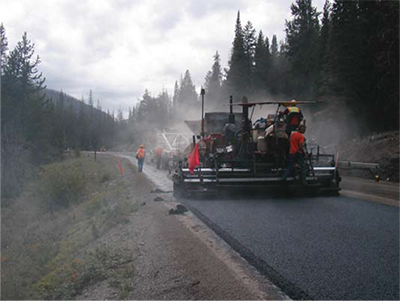
View larger version of Figure 5
Figure 5: Control mix laydown.
During these 4 days of paving, approximately 9,200 tons (8,350 metric tons) of the control mixture were placed. Aside from a few minor mechanical breakdown issues, the paving operations were smooth and uneventful.
Typical paving operations for the control mix are shown in Figures 2, 3, 4, and 5.
Placement of the Advera WMA began on August 26, 2007 and continued for four days. The Advera was added at a rate of 0.3% by weight of mix and was introduced at the plant via a port located just below the asphalt binder port (Figure 6). This allowed the zeolite powder additive to be blown into the binder during mix production thereby preventing any additive from escaping through the exhaust.
The placement of the mixture followed the same process as for the control mixture, as shown in Figures 7 & 8. The roller pattern was the same as the one that was established during the construction of the control strip.
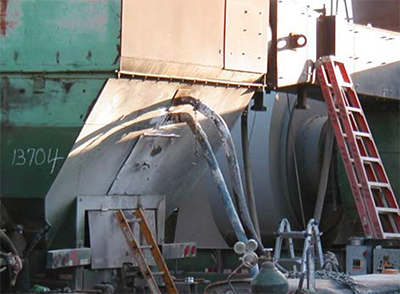
View larger version of Figure 6
Figure 6: Injection ports at the end of the drum: top port - asphalt binder, bottom port - warm mix additive.
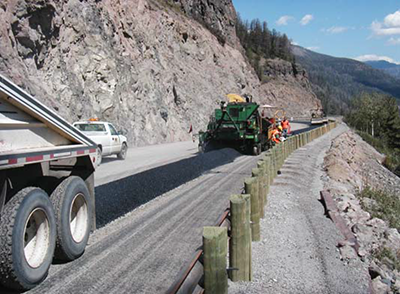
View larger version of Figure 7
Figure 7: Advera WMA deposited in windrow.
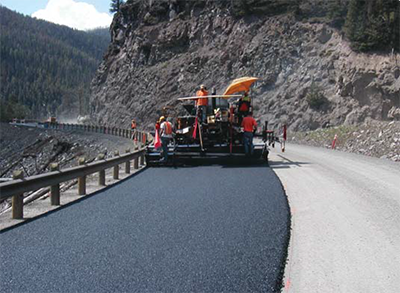
View larger version of Figure 8
Figure 8: Advera laydown operation.
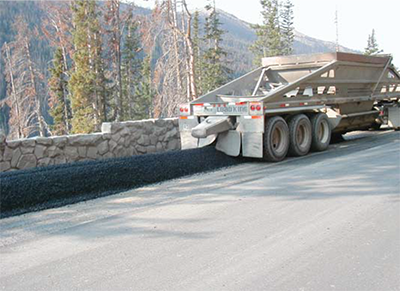
View larger version of Figure 9
Figure 9: Sasobit deposited in windrow.
The biggest issue in regard to the laydown temperature was obtaining consistency. During the production of the Advera WMA, it was difficult to maintain a constant production temperature. The cause of this was not definitively determined. Needing higher temperatures due to moisture in the aggregate or the burner not being properly adjusted to function properly at lower temperatures may have been contributing factors.
The workers noticed no handling differences using the Advera WMA compared to the control mix. The mixture was still easy to rake and manipulate when required and handled similarly to hot mix even at the lowest placement temperatures. The roller operators stated that the mix did not seem as tender as the hot mix and compaction was easily obtainable.
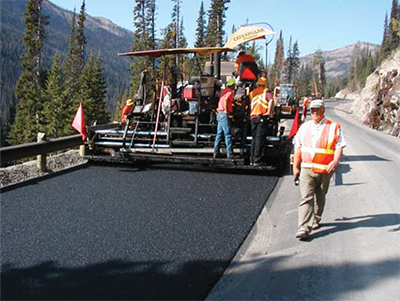
View larger version of Figure 10
Figure 10: Sasobit laydown operation.
Compared to the control mix, the major difference was the lack of visible smoke and fumes. Although no worker exposure testing was conducted during these trials, anecdotal information from the paving crew suggested better working conditions with the Advera WMA.
A total of 9,650 tons (8,750 metric tons) of Advera WMA were placed.
Placement of the Sasobit WMA (Figures 10 & 11) began on August 30, 2007 and was completed on September 7, 2007. There were four days of production paving during this interval with time off for the Labor Day holiday as well as one day of heavy rain on September 6. The weather for paving was similar to that of the control mix and Advera WMA; however, one of the days was cut short due to an afternoon rain storm.
The Sasobit wax prills were added to the mixture using the same drum port that the Advera product used with the exception of the port size. A reduction collar was needed to change the port connection from a 4-inch line used for the Advera to a 2-inch line for the Sasobit. This was needed due to the addition rate for the Sasobit being much lower than the rate for Advera. To produce the Sasobit WMA, Sasobit was added at a rate of 1.5% by weight of binder.
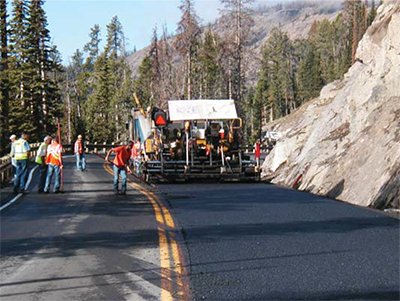
View larger version of Figure 11
Figure 11: Sasobit laydown operation.
Manufacturing conditions at the plant were similar to those of the Advera WMA. The plant initially established a target temperature of 275 °F (135 °C). After the first round of trucks, which provided approximately 600 tons (545 metric tons), the temperature was reduced to 250 °F (121 °C). Similar to the Advera WMA, the production temperatures fluctuated between 250 and 275 °F (121 and 135 °C), and it was difficult to maintain a consistent lower production temperature.
The workers noticed no handling differences between the Sasobit WMA and the control mix, even at temperatures as low as 230 °F (110 °C). The mix could be easily raked and leveled and had the same handling characteristics as hot mix even in the most difficult circumstances such as barrier wall tapers. The roller operator noted that density was easily achieved and felt that the mixture behaved similar to the Advera WMA. The roller pattern was the same as that used for the other two mixtures.
Again the major difference from a worker perspective was the reduced visible smoke and fumes. No worker exposure testing was conducted as part of this evaluation.
A total of 8,210 tons (7,450 metric tons) of Sasobit WMA was placed.